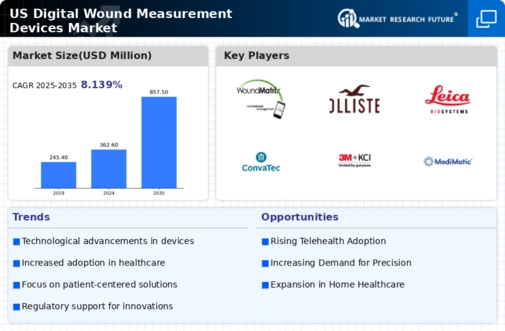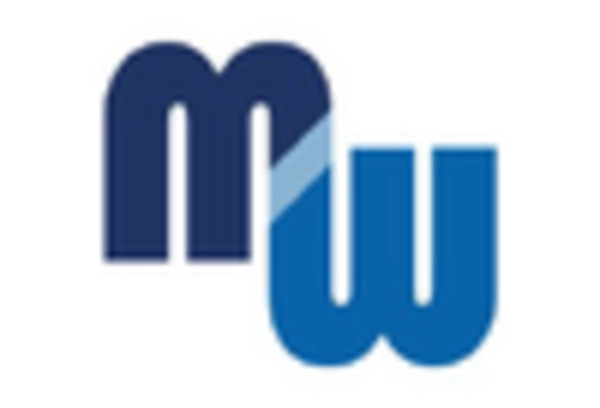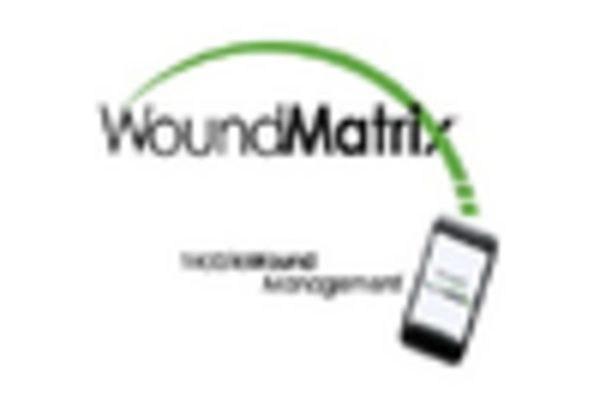Rising Incidence of Chronic Wounds
The increasing prevalence of chronic wounds, particularly among the aging population in the US, is a significant driver for the digital wound-measurement-devices market. According to recent statistics, chronic wounds affect approximately 6.5 million patients annually in the US, leading to a growing demand for effective management solutions. This demographic shift, coupled with the rising incidence of diabetes and obesity, contributes to the escalating need for advanced wound care technologies. Digital wound-measurement devices offer precise measurements and monitoring capabilities, which are essential for effective treatment plans. As healthcare providers seek to improve patient outcomes and reduce healthcare costs, the adoption of these devices is likely to increase, thereby propelling the market forward.
Integration of Telehealth Solutions
The integration of telehealth solutions into wound care management is emerging as a pivotal driver for the digital wound-measurement-devices market. With the growing acceptance of remote healthcare services, providers are increasingly utilizing digital wound-measurement devices to facilitate virtual consultations and monitor patient progress. This trend is particularly relevant in the context of managing chronic wounds, where timely interventions are crucial. The convenience of remote monitoring not only enhances patient engagement but also reduces the burden on healthcare facilities. As telehealth continues to gain traction, the demand for digital wound-measurement devices is expected to rise, reflecting a shift towards more efficient and patient-centered care models.
Shift Towards Value-Based Healthcare
The shift towards value-based healthcare is influencing the digital wound-measurement-devices market significantly. As healthcare systems in the US move away from fee-for-service models, there is an increasing emphasis on patient outcomes and cost-effectiveness. Digital wound-measurement devices play a crucial role in this transition by providing accurate data that can be used to assess treatment efficacy and optimize resource allocation. By enabling healthcare providers to demonstrate improved patient outcomes, these devices align with the goals of value-based care. Consequently, the demand for digital wound-measurement devices is likely to grow as providers seek to enhance their value propositions in a competitive healthcare landscape.
Increased Investment in Healthcare Technology
The digital wound-measurement-devices market is experiencing a surge in investment as healthcare organizations prioritize technological advancements. In recent years, funding for healthcare technology has seen a notable increase, with investments reaching over $20 billion in the US alone. This influx of capital is driving innovation in wound care solutions, leading to the development of more sophisticated digital measurement devices. These advancements not only improve accuracy but also enhance the overall efficiency of wound management processes. As healthcare providers seek to adopt cutting-edge technologies to improve patient outcomes, the digital wound-measurement-devices market is likely to benefit from this trend of increased investment.
Growing Awareness of Wound Care Best Practices
There is a growing awareness among healthcare professionals and patients regarding the importance of effective wound care management. This heightened awareness is driving the digital wound-measurement-devices market as stakeholders recognize the benefits of utilizing advanced measurement technologies. Educational initiatives and training programs are increasingly emphasizing the role of accurate wound assessment in treatment outcomes. As healthcare providers adopt best practices in wound care, the demand for digital measurement devices is expected to rise. This trend reflects a broader commitment to improving patient care and ensuring that wounds are managed effectively, thereby supporting the growth of the digital wound-measurement-devices market.

















Leave a Comment